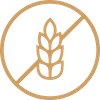Plant-based foods contain a large amount of fibre. They are able to pass through the small intestine undigested and enter the large intestine unchanged, where they develop their high swelling capacity and unfold various properties with the accumulated water.
The nopal prickly pear cactus (Opuntia ficus-indica), which belongs to the cactus family, is also called Indian fig. The cacti can grow into a sprawling shrub up to 6m high. It produces yellow flowers with a red ring at their base. On the blue-frosted shoots, the intensely yellow-red to violet fruit bodies (i.e., prickly pears) form, getting their colour from an abundance of phytochemicals, such as Indicaxanthin, a plant dye from the group of betalains. The fibre-rich leaves of the prickly pear cactus are botanically transformed into water-storing shoots, which have exceptionally fine hairs.
The carob tree (Ceratonia siliqua) can live for several hundred years and grow up to 12m high. The trees thrive on rocky soils and develop a strong, deep root system that enables them to absorb water and nutrients from deeper layers of soil. Traditionally, the pulp of the carob pods is dried and ground into a powder known as carob powder. The seeds, from which the natural thickening agent carob bean gum can be produced, are not included in the carob powder.

























